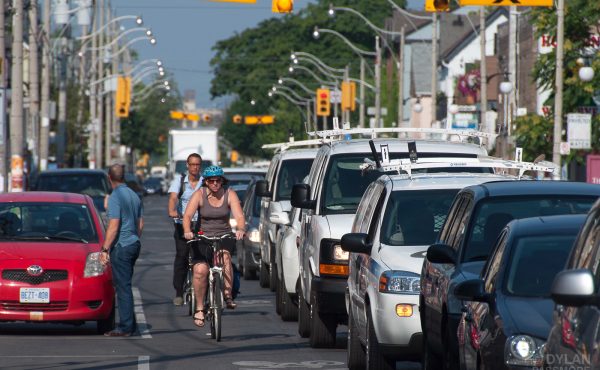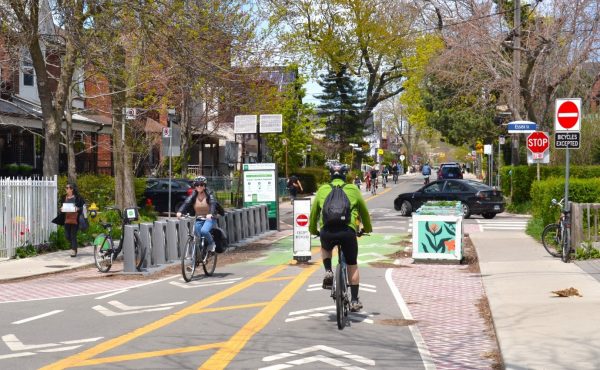When one thinks about cycling friendly cities in the United States, it’s cities like Portland or perhaps New York, with its recent high-profile bike lanes additions, that come to mind. However, Minneapolis has also proven to be a great cycling city (and was, in fact, named the number one cycling city in the United States by Bicycling Magazine in 2010). It ranks, according to the US Census Bureau, as the second highest percentage of bicycle commuters among the 50 largest cities in the US, with 3.9% of commuters using their bikes. Bike commuting has also doubled since 2000, with a drop of 20% in bike-car collisions recorded since the 1990s [PDF].
So I was excited when a few weeks ago I found myself in Minneapolis with ten days to kill and a fresh subscription to their public bike share program, NiceRide (supplied by Montreal’s Bixi, the same company that does Toronto’s). A one-year subscription to the system of 95 stations cost a mere $60, but as luck would have it was on sale for $30 during my trip.
Rails-to-Trails, Greenways, and Separated Paths
My absolute favourite part of biking in Minneapolis is using the greenways, which are pedestrian and cycling routes, often reclaimed from old rail corridors, which run through and around the city. Think the West Toronto Railpath, times a thousand. These greenways are not only completely separated from road traffic (the Midtown Greenway, pictured above, runs below grade with cross-traffic running through bridges over top), but they are serene places filled with greenery, gardens, and the occasional café or bike repair shop.
The city has also incorporated their many lakes into their greenway system. The Grand Rounds is a 50-mile winding bicycle and pedestrian path that encompasses almost the entire city. However, I did notice that many of the bike paths around the lakes were one-way only, leading me to believe that the city expected them to be used more for recreation than for commuters.
Now, the geography of Minneapolis, with its myriad lakes, is quite different from Toronto and allows for more opportunities for these types of pathways. However, there are still places in Toronto where similar off-street pathways could exist (completing the West Toronto Railpath would be a good start). As much as people have scoffed at Rob Ford’s fixation on creating bicycle trails through Toronto’s ravine system, we can learn from Minneapolis in that greenways, when planned seriously and with a mind to connectivity can really enhance and create great opportunities for safe and enjoyable urban cycling. The thing is that you have to make them go somewhere and connect to things if they are to be used by commuters as well as recreational cyclists.
During my stay in Minneapolis I used a greenway or separated off-street path almost daily. These connected me from where I was staying in Uptown, Minneapolis to the downtown core of the city and many other places. There were times these separated paths ran alongside roads at the same grade as the sidewalk and then continued seamlessly through parks, around lakes, and down into old rail corridors.
The city also contains many bicycle- and pedestrian-only bridges, such as the Martin Olav Sabo Bridge that connects the greenway over and around Minneapolis’ urban highway system. Just sayin’.
On the Road
Greenways and lake routes are all well and good, but only if they connect to a good street system. According to the City’s bicycle website, Minneapolis has 46 miles (about 74 km) of on-street bicycle lanes, with more planned for the future. I actually encountered very few bicycle lanes in the city, but also found that the level of traffic on many of the roads I was travelling, including those located in the downtown core, was such that I didn’t feel squeezed out.
What I did encounter were sharrow lanes that were painted green, where bikes and cars shared a lane space. This painted green lane did not give cyclists a dedicated space on the road, but acted like a visual cue to drivers that they should expect and give space to cyclists (for more on what these look like and how they work, check out another blog post I wrote).
Colour is being used more and more in bicycle infrastructure in order to alert drivers to the presence of cyclists on the road. New York, Vancouver, and Portland use colour in their bike boxes and through intersections. Toronto would do well to follow suit.
Minneapolis also unveiled its first bicycle boulevard this summer, with plans for five more in the works. A bicycle boulevard is a low-traffic, usually residential street, that runs parallel or near an arterial road that allows slow, safe travel for cyclists. Vancouver has bicycle boulevards, as does Portland, and there are several opportunities for them in Toronto.
NiceRide
If you have ever used a Bixi bike in Toronto, you’ll know what the experience of using the Minneapolis NiceRide system is like. However, NiceRide occupies a larger geographical space, with stations spread out farther than Toronto’s. This allowed me to ride pretty far out of the city’s centre while still being able to find a docking station. Yes, sometimes I had to walk a few blocks after docking my bike at one of these outer stations, but it made a huge difference in the usability of the system to be able to travel farther.
NiceRide has future plans to expand into more neighbourhoods in Minneapolis and even encompass the neighbouring city of St. Paul. Calls for expansion in Toronto’s system has focused on the fact that the busiest stations in Toronto are the ones at the systems edges. Indeed, if NiceRide only contained stations within the downtown core of Minneapolis, it would have been virtually useless to me.
I was sad to dock my final NiceRide bike and leave that beautiful city with its lakes and greenways and disarmingly nice population. Toronto could do worse than look to Minneapolis for a few tips-and-tricks to urban cycling.
all photos by the author







2 comments
Great post. Unfortunately Ford Nation refuses to acknowledge such concepts as “best practices”, “case studies” or “examples”. They don’t even think other cities exist. Short of luring a bunch of Fordies into a darkened room with a false offer of Timbits, then locking the doors and projecting images like these on the walls, I’m not sure how you get them to realize that there are successful cities out there doing good things with bikes worth emulating.
To stand still while other cities move on with cycling infrastructure, even (gag) American ones… Toronto will be in the dark ages for a long time…
Good post Jake. I just came across an interesting Canadian addition to the debate: http://www.cbc.ca/news/interactives/map-biking-940/
Even CBC is getting in on the action – ! You can’t help but notice that most cities have been working on their plans and renewing them by ADDING, not subtracting.